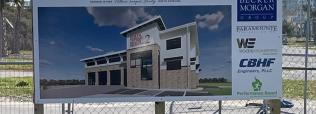Shoreline Protection Glossary
Accretion
Historically, accretion was the gradual addition of sand to a parcel of oceanfront property through the natural action of the Atlantic Ocean. Today, accretion typically also encompasses the historical terms reliction and avulsion. A reliction is the expansion of an oceanfront parcel of property due to a portion of the property which was previously covered by water becoming dry when the water recedes. An avulsion is a rapid addition of sand to a parcel of oceanfront property through natural processes or through human driven forces such as a beach nourishment project.
Accretions of sand generally belong to the oceanfront property owner. However, under North Carolina law, the title to any addition to the portion of the ocean beach seaward of the mean high water mark which is caused by a publicly funded beach nourishment project vests in the State of North Carolina.
Beach Nourishment
The placement of sand on the beach or dunes by human driven means. Typically, sand is provided through the use of mechanical or hydraulic dredging of material from a borrow site which is pumped to the site of the beach nourishment and distributed upon the beach by mechanical equipment.
Beach Renourishment
Beach nourishment occurring upon an area of the beach which has already been the subject of an initial beach nourishment project.
Benthic Monitoring
The monitoring of organisms that live on the sub-aquatic bottom. The Town is required to perform benthic monitoring as part of its beach nourishment project permit. The information obtained from benthic monitoring is often considered to be a suitable indicator of stresses on the marine environment and can act as an early warning system of potential issues with a beach nourishment project. Benthic monitoring can also be used to show the rate of recovery of the marine environment following a beach nourishment project.
Borrow Site
The site from which sand is obtained for placement on the beach during a beach nourishment project. Typically, a borrow site is chosen because of the amount of sand available and the consistency of the sand with the natural sand existing upon the beach to be nourished. A borrow site may be located on land, in the sound or in the Atlantic Ocean.
Cross-Shore Transport
A wave and/or tide generated movement of sand toward or away from the shoreline.
Dredging
The removal of sediment or the excavation of tidal or subtidal bottom materials to provide sufficient depths for navigation or anchorage, or to obtain material for construction or for beach nourishment.
Dry Sand Beach
Historically, the area of the ocean beach which was actually dry at the time it was being viewed. Legally, the term dry sand beach is often defined as the portion of the ocean beach that is landward of the mean high water mark. The dry sand beach may be privately owned, but it remains subject to public trust rights.
Dune
Any hill, mound, or ridge of sand on the coast whether created by natural or artificial forces.
Easement
A right of use over the property of another. With regard to beach nourishment, a property owner will grant an easement to the Town for the limited and specific use of a portion of the owner's property during the beach nourishment project. The limited and specific use will allow the Town to place sand on the owner's property to provide a consistent beach contour, to allow the Town to maintain the dunes created, and to allow the Town access to the property to inspect, maintain and repair the nourished beach area.
Equilibration
Equilibration is the process by which a mechanically built beach restores to its natural profile.
Erosion
Generally, the wearing away of land by the action of natural forces whether the result of gradual or rapid (avulsive) processes, such as wave action, tidal currents, littoral currents, wind, or storm events. If through erosion any area of land moves below the mean high water mark, the oceanfront property owner no longer has title to that area and title becomes vested in the State of North Carolina.
Erosion Escarpment
A vertical drop in the beach profile caused from high tide or storm tide erosion.
Frontal Dune
The first dune located landward of the ocean beach. The N.C. Division of Coastal Management defines this dune as the first dune having sufficient vegetation, height, continuity and configuration to offer protective value. The toe of the frontal dune is the seaward extent of the frontal dune and it begins where the contour of the dune rises up from the landward extent of the ocean beach creating a distinct change in slope or elevation. Where an erosion escarpment exists on the seaward edge of a frontal dune, there will often be no visible toe of the dune and the erosion escarpment will represent the seaward extent of the frontal dune.
First Line of Stable Natural Vegetation
Looking landward, the first point on the oceanfront where natural vegetation is present. When a first line of stable natural vegetation exists on a parcel of property, it is a natural indicator of the boundary between the dry sand portion of the ocean beach and upland property. In areas where there is no visible stable natural vegetation present, this line is often established by connecting or extending the lines from the nearest adjacent first lines of stable natural vegetation existing on either side of the site.
Hydraulic Sand Placement
The transportation of sand using water and centrifugal pumps mounted on a barge or large seagoing vessel (hydraulic dredging), from one site to another for placement of the sand on the second site. In the case of the Town’s beach nourishment project, hydraulic sand placement will be used to move sand from the borrow site to the land where beach nourishment is occurring.
Littoral Rights
Rights of an oceanfront property owner which include the right of access over their property to the Atlantic Ocean and the right to construct wharves, piers, or landings. Littoral rights are qualified rights which are subject to regulation by the State and local authorities.
Longshore Transport
A wave and/or tide generated movement of sand parallel to the shoreline.
Mean Low Water Elevation
A vertical elevation determined from tidal datum information maintained and provided by the National Oceanic and Atmospheric Administration (NOAA). NOAA calculates the mean low water elevation at its tidal stations as the average of all the low water heights observed over an approximately 19 year period known as the National Tidal Datum Epoch or in some cases for shorter periods of observation.
Mean Low Water Mark
Where the elevation of the land on property seaward of the mean high water mark intersects with the mean low water elevation determined to be associated with the property’s geographic location. A series of measured mean low water mark points can be connected to determine a contour line at the mean low water mark.
Mean High Water Elevation
A vertical elevation determined from tidal datum information maintained and provided by the National Oceanic and Atmospheric Administration (NOAA). NOAA calculates the mean high water elevation at its tidal stations as the average of all the high water heights observed over an approximately 19 year period known as the National Tidal Datum Epoch or in some cases for shorter periods of observation.
Mean High Water Mark
Where the elevation of the land on a parcel of oceanfront property intersects with the mean high water elevation determined to be associated with the property’s geographic location. A series of measured mean high water mark points can be connected to determine a contour line at the mean high water mark which crosses a parcel of property. The mean high water mark is the seaward boundary of all property within the State of North Carolina, not owned by the State, which adjoins the Atlantic Ocean.
Municipal Service District
North Carolina General Statutes allow for the creation of a Municipal Service District, which permits these districts to be established for a number of purposes, including beach erosion control and hurricane protection works. The General Statutes allows municipalities to define special service areas in order to assess additional property taxes and provide services within the areas that are additional to the services provided city or town wide.
Ocean Beach
The area adjacent to the Atlantic Ocean that people typically consider to be the “beach.” The entire ocean beach is subject to public trust rights. This area is in constant flux due to the action of wind, waves, tides, and storms and includes the wet sand area of the beach that is subject to regular flooding by tides and the dry sand area of the beach that is subject to occasional flooding by tides, including wind tides other than those resulting from a hurricane or tropical storm. Natural indicators of the landward extent of the ocean beaches include, but are not limited to, the first line of stable, natural vegetation; the toe of the frontal dune; and the storm trash line.
Primary Dune
The N.C. Division of Coastal Management defines the primary dune as the first dune located landward of the ocean beaches having an elevation equal to the mean flood level for the area plus six feet. The primary dune extends landward to the lowest elevation in the depression behind that same mound of sand which is commonly referred to as the dune trough.
Public Trust Area
The portion of the ocean beach subject to public trust rights.
Public Trust Rights
Public trust rights include, but are not limited to, the right of the public to navigate, swim, hunt, fish, and enjoy all recreational activities in the watercourses of the State and the right to freely use and enjoy the State's ocean and estuarine beaches and public access to the beaches.
Vegetation Line
See First Line of Stable Natural Vegetation.
Wet Sand Beach
Historically, the area of the ccean beach which was actually wet at the time it was being viewed. Legally, the term wet sand beach is often defined as the area of the ocean beach located seaward of the mean high water mark. The wet sand beach is subject to public trust rights. However delineated, title to any portion of the wet sand beach located seaward of the mean high water mark is held in trust by the State of North Carolina for the use of the public.
Courtesy of the Town of Nags Head, NC.
*DISCLAIMER: The definitions stated above are intended to provide a lay reader with a general understanding of various terms associated with the Town of North Topsail Beach’s beach nourishment project. The terms defined may have additional technical legal definitions or issues associated with them.
North Topsail Beach would like to thank the Town of Nags Head for this information.





